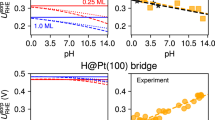Abstract
Contrary to some recent publications, the trivial definition of the surface charge density q = Q/A does not give any information about the charge Q and area A. Therefore this definition cannot be used as a “simple check,” rejecting results of electrochemical experiments where the values Q and A are the independent variables. Experimental confirmation and practical applications can be the two self-contained checks for the equations of solid-state electrocapillarity. Along with thermodynamics, the kinetic aspect is important here since the charge and area can oscillate in the large frequency range. Cycling the surface charge gives the three different contributions to the alternating surface tension of solids, corresponding to the double layer charging, reversible chemisorption, and discrete transitions closed within the rigid surface layer. The derivative of the charge density with respect to elastic deformation represents chemisorption and can be decreased to negligibly small value at the point of zero charge by increasing the frequency. On the base of the solid-state electrocapillarity, the dependence between the adsorption energy and elastic deformation was measured for the first time. It was thus found that stretching reinforces the bonding of hydrogen to the platinum surface. Acting inside the rigid surface monolayer, the alternating surface tension of solids is an independent tool in solving some complex problems of electrochemistry and solid-state physics. Two consecutive transitions are discovered on platinum instead of two coexistent hydrogen states which earlier were associated with two waves of the charging current. There are three consecutive hydrogen states separated along the potential axis by transitions from one state to another. Similar surface transitions are observed also on iridium, rhodium, and palladium. The number of transitions coincides with the number of finite radial nodes of the wave functions formed by d-electrons of these metals.






Similar content being viewed by others
References
Frumkin AN (1963) In: Delahay P (ed) Advances in electrochemistry and electrochemical engineering. Interscience, New York, pp 287–391, Vol. 3
Breiter MW (1963) Ann New York Acad Sci 101:709
Delahay P (1965) Double layer and electrode kinetics. Interscience, New York
Frumkin AN (1979) Potentials of zero charge. Nauka, Moscow (In Russian)
Damaskin BB, Petrii OA (2011) J Solid State Electrochem 15:1317
Marichev VA (2010) Surface Science 604:458
Gutman EM (2012) J Solid State. Electrochem. doi:10.1007/s10008-012-1644-4
Gutman EM (2011) Surf Sci 605:1923
Gokhshtein AY (1966) Elektrokhimia 2:1061, Zavodskaya Laboratoriya 32:815, Inventors certificate of USSR 178161
Gokhshtein AY (1969) Doklady Akademii Nauk SSSR 187:601, Inventors certificates of USSR 265552, 268746
Gokhshtein AY (1970) Electrochimica Acta 15:219
Gokhshtein AY (1976) Surface tension of solids and adsorption. Nauka, Moscow (In Russian)
Gokhshtein AY (1998) Patent of Russian Federation 2119655
Gokhshtein AY (2000) Physics—Uspekhi 43:725
Author information
Authors and Affiliations
Corresponding author
Rights and permissions
About this article
Cite this article
Gokhshtein, A.Y. On the “simple check” of electrocapillarity. J Solid State Electrochem 16, 3683–3689 (2012). https://doi.org/10.1007/s10008-012-1843-z
Received:
Revised:
Accepted:
Published:
Issue Date:
DOI: https://doi.org/10.1007/s10008-012-1843-z



